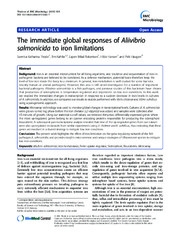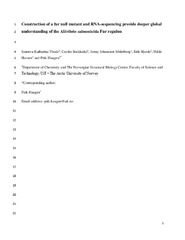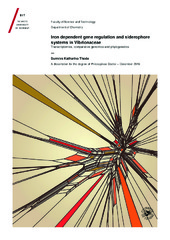| dc.contributor.advisor | Haugen, Peik | |
| dc.contributor.author | Thode, Sunniva Katharina | |
| dc.date.accessioned | 2019-03-15T11:06:29Z | |
| dc.date.available | 2019-03-15T11:06:29Z | |
| dc.date.issued | 2017-03-15 | |
| dc.description.abstract | Bacteria live in fluctuating environments, which they sense and respond to through gene regulation. Availably of iron is an example of an element fluctuating and that can Bacteria sense.Iron is an essential micronutrient that is scares in several environments, especially in a host. The ferric uptake regulator, Fur, is the major iron level sensing protein and regulator of iron acquisition systems in Bacteria. Fur act in a repressive manner. Under low iron conditions, Fur is inactive and iron acquisition systems are expressed. Within the Vibrionaceae bacterial family, there are several pathogen representatives with sophisticated iron acquisition systems. The iron acquisition systems are essential for survival and the virulence of the pathogen colonizing a host.
In the present work, the cold-adapted fish pathogen Vibrionaceae representative, Aliivibrio salmonicida, has been used as a model for understanding the Fur regulon and the immediate responses of iron limitations. Also, the siderophore-based iron acquisition systems of the Vibrionaceae family have been investigated. In Paper 1, transcriptomic studies resulted in identification of the first transcriptional responses of A. salmonicida to iron limitations. Pan-transcriptome studies identified shared and unique strategies to iron limitations between the Vibrionaceae representatives, A. salmonicida, Vibrio vulnificus, and Vibrio cholerae. In Paper 2, transcriptomic studies of an A. salmonicida fur null mutant provide deeper and more fine-grained data of the Fur regulon in A. salmonicida. Also, targets are predicted for the sRNA RyhB and novel small RNA predictions are provided. Paper 3, provide deeper understanding of the patterns, origin, distribution, and evolution of Vibrionaceae siderophore biosynthesis systems and receptors.
Overall, results from these studies have increased our understanding of the A. salmonicida Fur regulon and strategies of surviving iron limitations. For the Vibrionaceae siderophore based iron acquisition systems, we have broadened the knowledge of distribution of the siderophore biosynthesis systems, receptors and the evolution within the family. | en_US |
| dc.description.doctoraltype | ph.d. | en_US |
| dc.description.popularabstract | Iron dependent gene regulation and siderophore systems in Vibrionaceae.
Expression of iron uptake systems in disease-causing bacteria (e.g., Vibrio cholerae, Vibrio vulnificus, Aliivibrio salmonicida) are crucial for survival and ability to cause infection in a vertebrate host, as restriction of free iron is part of the hosts innate immune system. This research contributes to the knowledge on iron dependent gene regulation and siderophore based iron uptake systems.
Iron is an essential micronutrient for most lifeforms, but can also cause problems in cells due to toxicity and poor solubility. Expression of iron uptake systems must therefore be carefully regulated. In Bacteria, Fur is the major regulator of production of iron uptake systems. The activity of Fur is directly dependent on the concentration of free iron. Iron levels are extremely low inside vertebrates as restriction of free iron is an innate immune strategy against bacterial infection. Bacteria can counteract, and survive such defense systems by producing extremely efficient iron uptake systems. Siderophore based iron uptake systems are widespread and particularly important for disease-causing bacteria. The Vibrionaceae family is a large, and well-studied, bacterial family with several disease-causing representatives, making the family suitable as models for studying iron uptake systems.
We have used the disease-causing Aliivibrio salmonicida (causes disease and mortality of fish, i.e., cold-water vibriosis, or “Hitra” disease) as a model to identify which genes Fur regulate, and for understanding the first gene regulation responses in the transition from normal to poor iron-containing environments. We identified 296 genes that are regulated by Fur, and 32 genes that fast responding to low iron conditions. The siderophore producing system was among the fastest responding genes, and is tightly regulated by Fur. We have also compared gene sets coding for siderophore producing proteins and siderophore receptors, and used bioinformatics to predict which Vibrionaceae representatives can produce and receive the different siderophores. Finally, we investigated the origin and evolution of the siderophore systems. We identified 60 systems distributed among 42 Vibrionaceae species and 330 siderophore receptors among 78 Vibrionaceae species. Each species typically produce at least one siderophore and several siderophore receptors.
Results from these studies have increased our understanding of the functional roles of Fur in A. salmonicida, and which strategies A. salmonicida use to survive in environments with low iron supply. Also, we have broadened the current knowledge on how siderophore biosynthesis systems and siderophore receptors are distributed within the bacterial family Vibrionaceae, and established the origin and evolution of some of these systems. | en_US |
| dc.description.sponsorship | The National graduate school in structural biology – Biostruct, and UiT the Arctic University of Norway | en_US |
| dc.identifier.isbn | 978-82-8236-250-4 (trykt) og 978-82-8236-251-1 (pdf) | |
| dc.identifier.uri | https://hdl.handle.net/10037/14984 | |
| dc.language.iso | eng | en_US |
| dc.publisher | UiT Norges arktiske universitet | en_US |
| dc.publisher | UiT The Arctic University of Norway | en_US |
| dc.relation.haspart | <p>Paper I: Thode, S.K., Kahlke, K., Robertsen, E.M., Hansen, H. & Haugen, P. (2015). The immediate global responses of <i>Aliivibrio salmonicida</i> to iron limitations. <i>BMC Microbiology</i>, 15:9. Also available at <a href=https://hdl.handle.net/10037/8843>https://hdl.handle.net/10037/8843. </a><p>
<p>Paper II: Thode, S.K., Bækkedal, C., Söderberg, J.J., Hjerde, E., Hansen, H. & Haugen, P. (2017). Construction of a <i>fur</i> null mutant and RNA-sequencing provide deeper global understanding of the <i>Aliivibrio salmonicida</i> Fur regulon. (Manuscript). Published version available at <a href=https://hdl.handle.net/10037/11883>https://hdl.handle.net/10037/11883. </a><p>
<p>Paper III: Thode, S.K., Kozlowski, M., Rojek, E., Ahmad, R. & Haugen, P. Distribution, origin and evolution of siderophore systems in <i>Vibrionaceae</i>. (Manuscript).
Published version with altered title available at <a href=https://hdl.handle.net/10037/14985>https://hdl.handle.net/10037/14985. </i><p> | |
| dc.rights.accessRights | openAccess | en_US |
| dc.rights.holder | Copyright 2017 The Author(s) | |
| dc.rights.uri | https://creativecommons.org/licenses/by-nc-sa/3.0 | en_US |
| dc.rights | Attribution-NonCommercial-ShareAlike 3.0 Unported (CC BY-NC-SA 3.0) | en_US |
| dc.subject | VDP::Teknologi: 500::Bioteknologi: 590 | en_US |
| dc.subject | VDP::Technology: 500::Biotechnology: 590 | en_US |
| dc.subject | VDP::Matematikk og Naturvitenskap: 400::Basale biofag: 470::Molekylærbiologi: 473 | en_US |
| dc.subject | VDP::Mathematics and natural science: 400::Basic biosciences: 470::Molecular biology: 473 | en_US |
| dc.subject | VDP::Matematikk og Naturvitenskap: 400::Basale biofag: 470::Genetikk og genomikk: 474 | en_US |
| dc.subject | VDP::Mathematics and natural science: 400::Basic biosciences: 470::Genetics and genomics: 474 | en_US |
| dc.title | Iron dependent gene regulation and siderophore systems in Vibrionaceae | en_US |
| dc.type | Doctoral thesis | en_US |
| dc.type | Doktorgradsavhandling | en_US |


 English
English norsk
norsk




